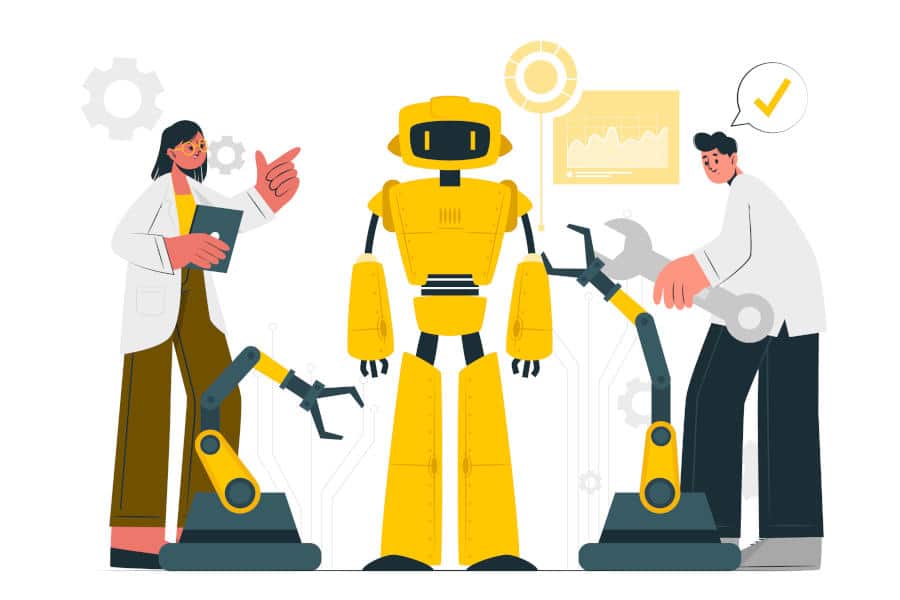Proximal Policy Optimization is a Reinforcement Learning algorithm created by OpenAI, ideal for complex environments such as video games or robotics. Find out all you need to know about its history, how it works and how to use it!
In the field of Machine Learning, Reinforcement Learning has been enjoying a remarkable boom over the past few years, due to its potential for solving complex problems.
Inspired by the human concept of learning by trial and error, this approach involves the creation of agents capable of learning through interaction with their environment to achieve specific goals.
These agents must develop policies, i.e. strategies, to maximize a cumulative reward over time. They perform actions and receive rewards or penalties in return, and adjust their policies to maximize the reward.
However, managing to optimize these policies while maintaining learning stability represents a major challenge. To meet this challenge, OpenAI, the company behind ChatGPT, has created an innovative algorithm: PPO, or Proximal Policy Optimization.
What is it?
It was in 2017 that the paper “Proximal Policy Optimization Algorithms” was published by OpenAI researchers John Schulman, Filip Wolski, Prafulla Dhariwal, Alec Radford and Oleg Klimov.
Their aim was to overcome the limitations of existing Reinforcement Learning algorithms, particularly in terms of training stability and handling complex action spaces.
When optimizing policies in Reinforcement Learning, overly aggressive updates can compromise training.
The PPO introduces a new notion into this process: proximity. This ensures that updates are not too far removed from previous policies.
This approach is inspired by the concept of “clipping”, which aims to limit the extent of updates to avoid abrupt changes. The result is more stable convergence and improved learning performance.
💡Related articles:
| Image Processing |
| Deep Learning – All you need to know |
| Mushroom Recognition |
| Tensor Flow – Google’s ML |
| Dive into ML |
Understanding the architecture and operation of the PPO
The algorithm is distinguished by its architecture, which combines key elements to enable stable and efficient learning in dynamic environments.
It follows an iterative approach: the agent interacts with the environment, collects training data, updates its policies according to the proximity principle, then repeats the process to improve performance over time.
This constant iteration is essential to enable the agent to adapt to complex and changing environments.

One of the key components is the value function, often implemented as a state value function (V) or an advantage value function (A) to evaluate the quality of the actions performed by the agent.
The advantage represents the difference between the actual reward obtained by the agent and the predicted value. This evaluation quantifies the relevance of current policies and guides future updates.
Agent policies are generally stochastic: they generate a probability distribution of possible actions. In this way, the agent can introduce exploration into its learning process to better discover optimal strategies.
💡Related articles:
How does the optimization process work?
It all starts with the agent’s interaction with the environment. It performs actions according to its current policy, observes the resulting state of the environment, and receives a reward or penalty.
These interactions generate data trajectories, which are then used to update the agent’s policy.
Once the data trajectories have been collected, the agent calculates the benefits by measuring the relative performance of each action against the predicted value.
This step enables it to determine which actions have contributed positively or negatively to the reward obtained by the agent. Depending on the result, the policy is updated using algorithms such as stochastic gradient descent.
The aim is to maximize the probability of the most advantageous actions. However, the proximity constraint limits policy changes to a certain threshold.
The iterative process is repeated several times, allowing the agent to gradually adjust to its environment and learn more efficient policies over time.
What are the advantages of PPO?
The use of this algorithm brings several major advantages. Firstly, as mentioned above, the proximity constraint contributes significantly to the stability of the training.
It avoids abrupt changes that could compromise the convergence of the algorithm. What’s more, PPO excels at managing extended spaces, enabling agents to handle complex environments with numerous and diverse actions.
Its flexibility also makes it adaptable to a wide variety of Reinforcement Learning tasks and application sectors. To better illustrate its advantages, let’s compare it with other algorithms.
PPO compared with other RL algorithms
The Reinforcement Learning landscape is rich in algorithms. A comparison helps us to better understand PPO’s distinctive advantages and its position within this sphere.
One of the best known is DDPG (Deep Deterministic Policy Gradients), which distinguishes itself by tackling problems involving continuous action spaces, where possible actions form an infinite set.
Unlike PPO, which excels at managing stochastic action spaces, DDPG uses deterministic policy. This means that it assigns a specific action to a given state, rather than a probability distribution.
TRPO (Trust Region Policy Optimization) shares with PPO the idea of maintaining stability when optimizing policies. However, it uses a trust region approach to limit policy changes.
This differs from PPO, which opts for a proximity constraint. This simplicity often makes it easier to implement and less sensitive to hyperparameters.

Another algorithm: SAC or Soft Actor-Critic. It focuses on learning efficiency in intensive exploration environments. Its entropy maximization encourages exploration, and distinguishes it from PPO. However, SAC may be more sensitive to the choice of hyperparameters and require fine-tuning for optimal performance.
Overall, PPO shines for its conceptual simplicity and ease of implementation, while maintaining solid performance. Its iterative approach with proximity constraint proves particularly beneficial in practical applications, as we shall now see.
What are the main applications?
The PPO has demonstrated outstanding performance in complex video games. A notable example is the AlphaGO AI. The algorithm has been used to train agents capable of outperforming human Go champions.
It has also been successfully applied to enable robots to learn complex tasks such as manipulating various objects in dynamic environments. It is therefore one of the algorithms at the heart of the upcoming humanoid robot revolution, which includes the Tesla Optimus.
In the financial sector, PPO is used to optimize automated trading strategies. Its stability and adaptability to changing market conditions make it an attractive choice for these sensitive applications.
And in the healthcare sector, it is used to design personalized treatment policies. It helps, for example, to dynamically adjust treatment protocols according to individual patient response.
This wide range of applications makes it a key algorithm in the new wave of artificial intelligences that are invading every field. And this is just the beginning: there are many more developments on the horizon…
PPO2 and future algorithm developments
A second “GPU-enabled” implementation called PPO2 has also been released by OpenAI. It runs three times faster than the Atari baseline.
In addition, the American firm also launched an implementation of the ACER (Actor Critic with Experience Replay) algorithm, which uses a replay buffer and a Q-Function trained with Retrace.
Several variants have emerged to solve more specific problems. Some introduce more sophisticated exploration mechanisms, while others focus on more advanced optimization strategies.
Research has explored the dynamic adaptation of hyperparameters for automatic adjustment to changing environmental or task characteristics.
The algorithm is increasingly integrated with imitation learning approaches, where the agent learns from human demonstrations. This integration facilitates the rapid acquisition of effective policies.
Researchers are also investigating the potential of learning transfer with PPO, to enable agents to apply knowledge acquired in one domain to related tasks and accelerate learning in new contexts.
In the future, we can expect more efficient exploration mechanisms, better management of high-dimensional action spaces for application to even more complex tasks, and enhanced interpretability of learned policies to make agents’ decisions more comprehensible.

Conclusion: Proximal Policy Optimization, a balance between stability and RL efficiency
Thanks to the notion of proximity, which prevents over-aggressive policy updates, PPO avoids undesirable oscillations in reinforcement learning. This perfect balance between stability and efficiency enables it to adapt to a wider variety of tasks.
Over the years, the algorithm has gained in popularity due to its ability to handle complex environments such as video games, robotics, finance and healthcare. It has become a benchmark for many applications.
To become an expert in Machine Learning, Reinforcement Learning and Artificial Intelligence, you can turn to DataScientest. Our distance learning courses enable you to acquire real mastery in record time!
The Data Scientist course covers Python programming, DataViz, machine learning and deep learning techniques, data engineering and MLOPS.
The module dedicated to complex models covers Reinforcement Learning, recommendation systems and graph theory. By the end of the course, you will have acquired all the skills required to become a Data Scientist.
You will receive a “Project Manager in Artificial Intelligence” certification from the Collège de Paris, a certificate from Mines ParisTech PSL Executive Education and an AWS Cloud Practitioner certification.
To take things a step further, we also offer a Machine Learning Engineer course. This combines the Data Scientist curriculum with modules dedicated to the development and deployment of artificial intelligence systems.
At a time when generative AI tools such as ChatGPT and DALL-E are booming, our Prompt Engineering & Generative AI training course will enable you to learn how to master these new tools by becoming a master in the art of formulating prompts.
Our various courses can be completed in an intensive BootCamp, either full-time or part-time. As far as financing is concerned, our state-recognized organization is eligible for funding options. Discover DataScientest!










